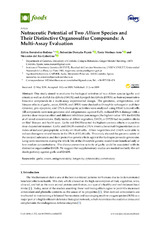Mostrar el registro sencillo del ítem
Nutraceutic Potential of Two Allium Species and Their Distinctive Organosulfur Compounds: A Multi-Assay Evaluation
| dc.contributor.author | Fernández Bedmar, Zahira Noemí | |
| dc.contributor.author | Demyda-Peyrás, S. | |
| dc.contributor.author | Merinas Amo, María Tania | |
| dc.contributor.author | Río-Celestino, Mercedes del | |
| dc.date.accessioned | 2019-06-21T11:39:49Z | |
| dc.date.available | 2019-06-21T11:39:49Z | |
| dc.date.issued | 2019 | |
| dc.identifier.uri | http://hdl.handle.net/10396/18765 | |
| dc.description.abstract | This study aimed to evaluate the biological activities of two Allium species (garlic and onion) as well as diallyl disulphide (DADS) and dipropyl disulphide (DPDS) as their representative bioactive compounds in a multi-assay experimental design. The genotoxic, antigenotoxic, and lifespan effects of garlic, onion, DADS, and DPDS were checked in Drosophila melanogaster and their cytotoxic, pro-apoptotic, and DNA-clastogenic activities were analyzed using HL60 tumoral cells. All compounds were non-genotoxic and antigenotoxic against H2O2-induced DNA damage with a positive dose-response effect and different inhibition percentages (the highest value: 95% for DADS) at all tested concentrations. Daily intake of Allium vegetables, DADS, or DPDS had no positive effects on flies’ lifespan and health span. Garlic and DADS exerted the highest cytotoxic effects in a positive dose-dependent manner. Garlic and DADS exerted a DNA-internucleosomal fragmentation as an index of induced proapoptotic activity on HL60 cells. Allium vegetables and DADS were able to induce clastogenic strand breaks in the DNA of HL60 cells. This study showed the genomic safety of the assayed substances and their protective genetic effects against the hydrogen peroxide genotoxine. Long-term treatments during the whole life of the Drosophila genetic model were beneficial only at low-median concentrations. The chemo-preventive activity of garlic could be associated with its distinctive organosulfur DADS. We suggest that supplementary studies are needed to clarify the cell death pathway against garlic and DADS. | es_ES |
| dc.format.mimetype | application/pdf | es_ES |
| dc.language.iso | eng | es_ES |
| dc.publisher | MDPI | es_ES |
| dc.rights | https://creativecommons.org/licenses/by/4.0/ | es_ES |
| dc.source | Foods 8(6), 222 (2019) | es_ES |
| dc.subject | Garlic | es_ES |
| dc.subject | Onion | es_ES |
| dc.subject | Antigenotoxicity | es_ES |
| dc.subject | Longevity | es_ES |
| dc.subject | Cytotoxicity | es_ES |
| dc.subject | Comet assay | es_ES |
| dc.title | Nutraceutic Potential of Two Allium Species and Their Distinctive Organosulfur Compounds: A Multi-Assay Evaluation | es_ES |
| dc.type | info:eu-repo/semantics/article | es_ES |
| dc.relation.publisherversion | http://dx.doi.org/10.3390/foods8060222 | es_ES |
| dc.rights.accessRights | info:eu-repo/semantics/openAccess | es_ES |

